If you’ve read my introduction to The Book of Haps then you’ll already have come across Helen Robertson – a Shetland artist and craftswoman whose work I deeply admire. Working with silver wire and other precious materials, Helen has developed a uniquely thoughtful aesthetic which celebrates, commemorates and reflects upon Shetland’s history and heritage – particularly that of the islands’ knitters. As well as being an important textile artist, Helen is also a popular jewellery designer – producing her own collections, and working on commission – and I find the same threads of thoughtful reflection running through all of her work, whether it is commercial or non-commercial. Indeed, Helen’s work speaks very powerfully to me on many different levels – as a researcher with a particular interest in the work of women, as someone with a deep love and respect for Shetland knitting, and as a craftswoman too. Quite apart from being taken with her work, it is fair to say that I feel an unusual kind of affinity with Helen: we are of a similar age, and despite being trained in completely different professional fields, through life’s twists and turns we have both ended up as makers. Helen talks interestingly below about how she simply can’t avoid creativity, can’t stop thinking about making, and can’t stop the making until the thing is made. It’s fair to say that her words resonate very strongly with me! Anyway, for so many reasons, I’m very pleased to be able to feature Helen and her work in our Oo book, and to bring you this conversation with her today. The post is a wee bit longer than usual, but Helen is well worth listening to, so settle in.
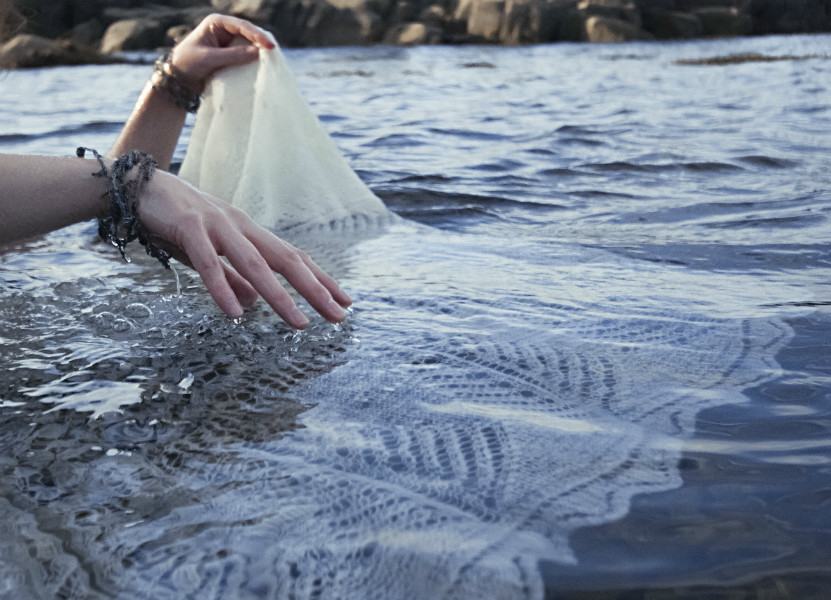
(the sea, and knitting – influences on Helen’s work, and powerful emblems of Shetland past and present)
KD: Can you tell us about your background and how you began your career in art and making?
HR: I grew up in Ronald Street in Lerwick believing it to be the best place in the world. We had everything as bairns in that street – the Waarie Geo, a rock pool on the shore where we could catch sticklebacks and crabs, the constant smell and sound of the sea, a communal patch of grass with 2 swings and a set of goalposts. We lived next to the Knab which was great for cycling, roller skating and brilliant for sledging. We had an old red telephone box, a post box and later on a small corner shop. If I stood outside our house, I could see my best friend’s bedroom window. We were 5 minutes walk to the street and the swimming pool and 20 minutes walk to the school. We took real pride in our street. At Halloween we would go guising around the houses and at Guy Fawkes we would light the streets’ bonfire at the head of Beiwick Bay while all the families would light their fireworks. At New Year all the neighbours would visit each other and our house would ring with music for nights. I feel quite teary thinking about it. It was very special and I feel privileged to have been part of it.

(Lerwick from the shore near the Knab. Tom shot this photo on black and white film during his last trip).
By my mid to late teens though I was keen to get away sooth (south). I ended up in Aberdeen and studied physics. I loved being in Aberdeen–there is something about being an islander in a city – the excitement of the new but the camaraderie and community of fellow exiled islanders – that is hard to beat. Throughout my student years, I was always makkin (knitting) away on a jumper, and also began creating jewellery with beads and wire and fimo. I didn’t see any of this leading to a career at the time but looking back through my life I was always making something. I was in awe of those that studied art and realise in retrospect that was the route I should have taken. I stuck at it though and finished my degree. I returned to Shetland where I completed a PGDip Comm Ed and developed a passion for teaching and learning, working in three rural areas of Shetland. During this time I was also designing and knitting fishermans hats – I hesitate to use the word ‘commercially’ – as the returns were so pitifully low (around £7 per day). I became pregnant with my first child in 2001 and this coincided with me starting to knit with wire. Over the next six years I had three more children, and completed commissions such as the “Lookin Up Lighting” work for the new Shetland Museum. I was glad to have some work to keep me sane but also very happy to be able to be home for most of this time with the bairns – chaotic though it was.

KD: In what ways does Shetland, past and present, provide a source of inspiration for your work?
HR: Growing up with a keen family historian as a mam, I was always told snippets of stories about folk from my own family tree. The essence of their struggle has stuck with me. I have tried to express an appreciation of their struggle through my work and also tell their story to a wider audience. I also feel that collectively though we have moved on there are still folk locally and in the wider world that face their own struggles through inequality of status and income.
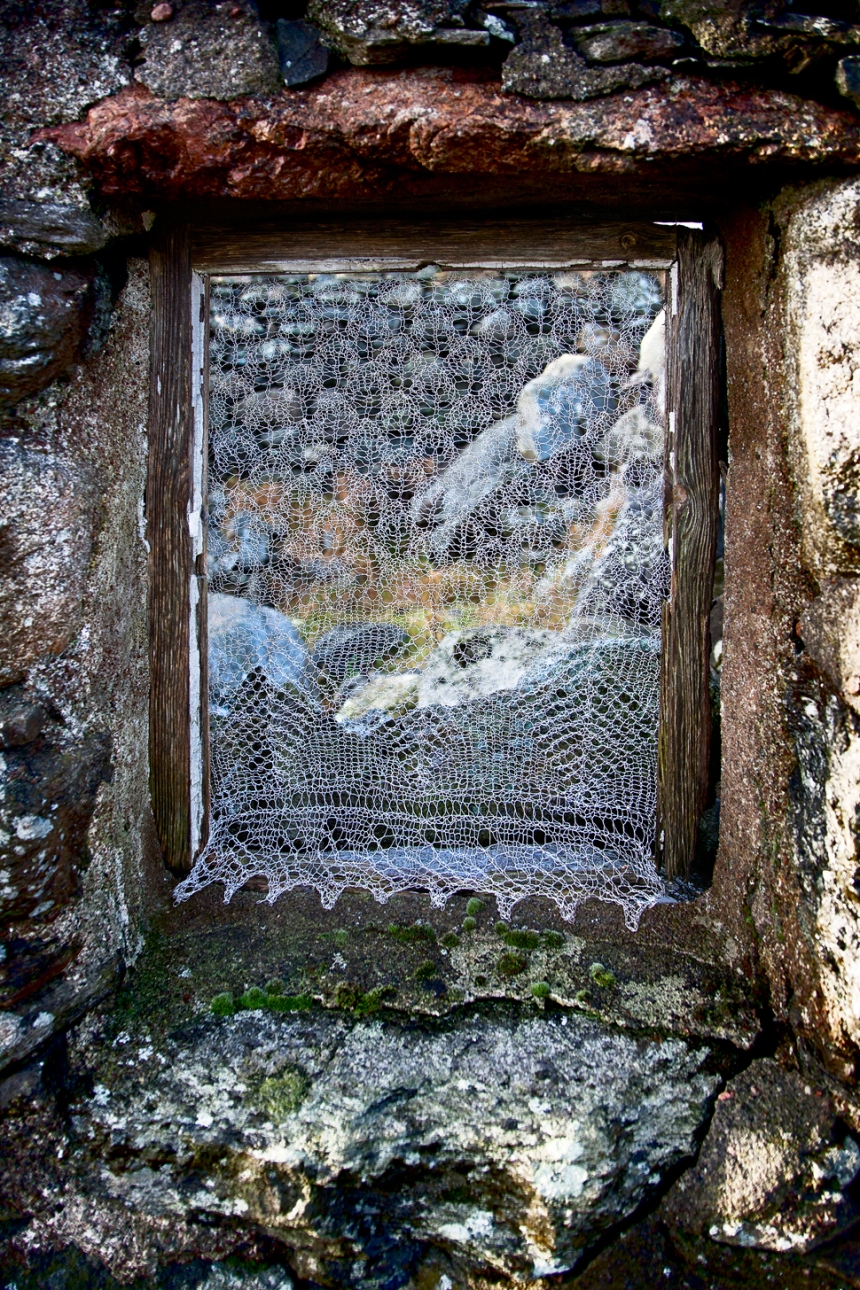
(Helen’s lace window, installed in a ruined croft at Crugga, knitted with silver wire).
I also feel a connection with nature that I’m not really conscious of on a day to day basis but I think I absorb subliminally. I do need to be near the sea, and by near, I mean able to see it and preferably smell it. My Loki Collection was inspired directly from the pieces of birch bark that float to Shetland from Canada. I love being able to wear a silver replica as a reminder of the journey and of the joy of making the land and the subsequent joy of the find.
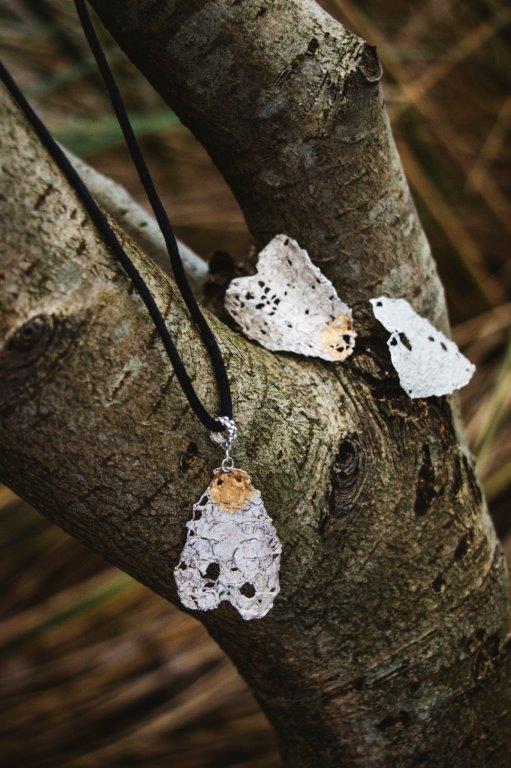
(Helen’s Loki collection)
In my handknitting I love using colour and am very inspired by the gorgeous range of colours now available in Shetland yarns. I’m currently researching and testing vitreous enamels in colours to match. I’m not really sure where I’m going with it yet, maybe bespoke buttons, earrings to match existing garments? But I’m loving the process.

(Fair Isle stud earings, inspired by the old process of dotting out a pattern)
KD: Can you tell me more about your piece commemorating the Gloup Fishing disaster of 1881 (in which 58 men from Shetland’s North Isles lost their lives, leaving 34 women widows and 85 children orphans)?
Like many of my pieces, this one was in my head for a long time. I had a visual image of a deckchair made with a sling seat made using the Print o’ da Wave pattern using old (blackened cotton) fishing line, sitting on an empty beach. The image came first, then I realized how well it visualized the contrast between our contemporary lifestyles and those of the families of the past, including the women who originally created that fabulous pattern and the men and their fishing that inspired it. As a child, I went to the erection of the Gloup Memorial in Yell in 1981 to commemorate the men who lost their lives and the struggle of the women that were left behind. The experience stayed with me and I recently found out that as the sixareens (open wooden rowing boats) that were lost were owned by the lairds, the lairds charged the widows for the loss of the boat, and that this in turn led to them being evicted as they had no money. So they lost their man (possibly also their brothers and their father), their income, their croft and thus the means to support their family and their home. My own great grandfather, James Thomson and his brother Magnus died in the disaster and the family also lost my great grand uncle, William Anderson, who was aged just 19 and had gone to sea that day in place of a regular crew member. . .

(Helen’s recent piece inspired by the Gloup Fishing Disaster. The figures of drowning men are caught in the print o’ da wave).
. . . so I’m not sure what came first, the image or the idea but I had the victims of the Gloup disaster in mind when planning the piece. I wanted to knit it in a similar yarn to that used for the fishing lines (which were couched cotton). Anyway after many years of trying to find the right yarn and the right time I decided to compromise and use modern marine twine but I treated this with creosote to give an authentic smell.
KD: When did you start making jewellery for sale? And what kinds of commissions do you most enjoy?
HR: I first combined my jewellery making with my knitting in 2001 when I was commissioned to make a tiara. The old tradition of brides knitting a fine lace shawl (wedding ring shawl) and wearing them as a veil gave me the inspiration. I wanted to link to this but in a modern way. This led to me making lace cuffs to match and I realized I had an unique, original piece and a new way of wearing Shetland lace that could open it up to new audience and lead to more universal acclaim for the skill and ingenuity of the knitters of Shetlands’ past.
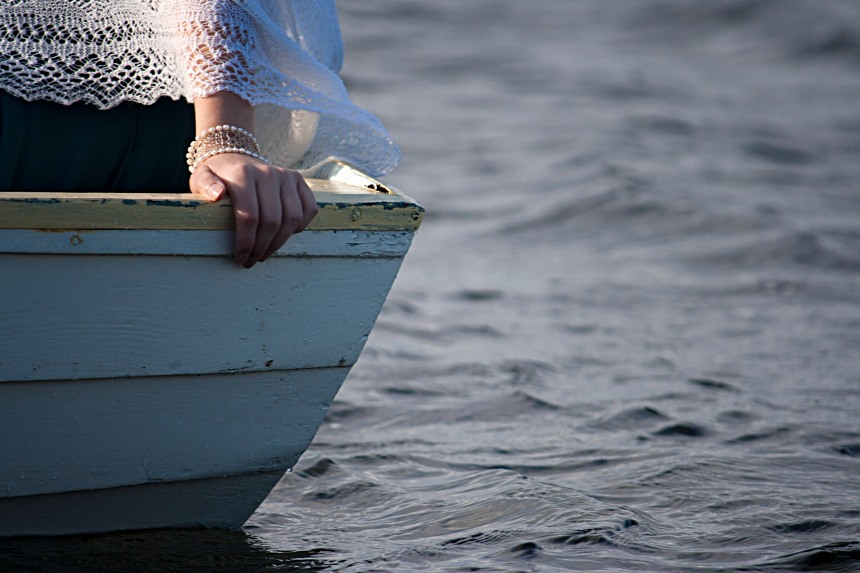
(Lace bracelet)
I am always honoured to be asked to create something special for a bride to be, but I also enjoyed creating a trio of lace cuffs for 3 sisters. They were meant as graduation presents and I worked alongside their mother to design three very different lace cuffs to match the personality of each sister. I was delighted when their younger sister was able to identify which bracelet was for which sister. I am also particularly delighted when my knit jewellery is commissioned or bought by a fellow knitter – that feels like a real endorsement and I feel that they are getting the story.
Some of my customers have told me that they enjoy the complete difference of my work from other jewellery they’ve seen. I need to try and treasure that and not get into the trap of making similar jewellery to other folk though I sometimes find this hard when the more “usual” pieces tend to find an easier market!

(Tree of Life earrings and pendant)
KD: I think of you very much as an intellectual maker – certainly an artist as much as a craftswoman. Do you draw distinctions between art and craft in the work that you produce?
I have thought a lot about this and do feel that my work straddles both fields. The difference for me is that with a craft item, I know what the final outcome will look like and I know when it is finished, there is a pattern for the piece that I have written and I can teach other folk to make a similar piece, (an example of this would be my Heritage Collection of Lace Cuffs or earrings.) The craft items are more accessible and frankly easier to sell. The art pieces are more niche. A balance of the two works for me just now. Too much art would exhaust me, too much craft would bore and frustrate me as I struggle to make the same thing twice.
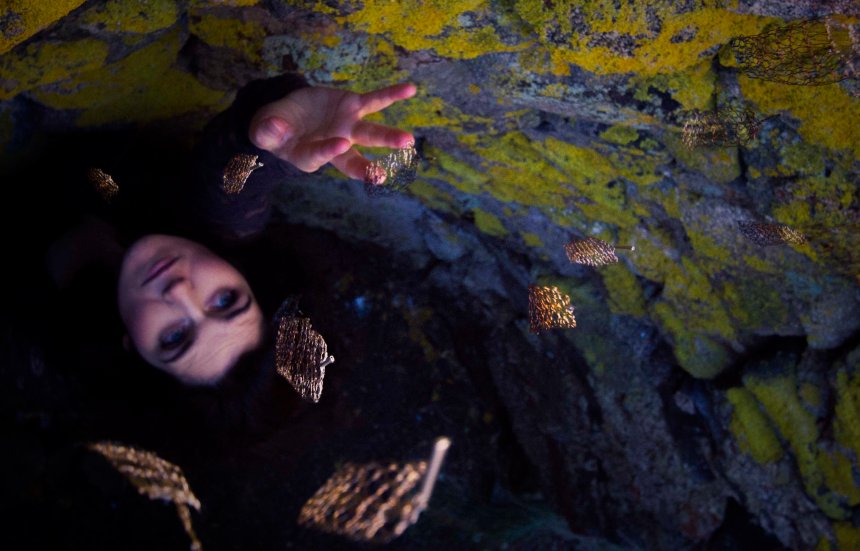
(Falling feathers)
With my art items the end of the journey is never as clear and there is no written record of how it’s made – it emerges as I engage with the inspiration, the materials and process. There is no pattern and I couldn’t teach anyone else to make it. It comes from somewhere inside me and is a more tiring, if more satisfying process, an example of this would be Crang. It feels more like a piece of me.
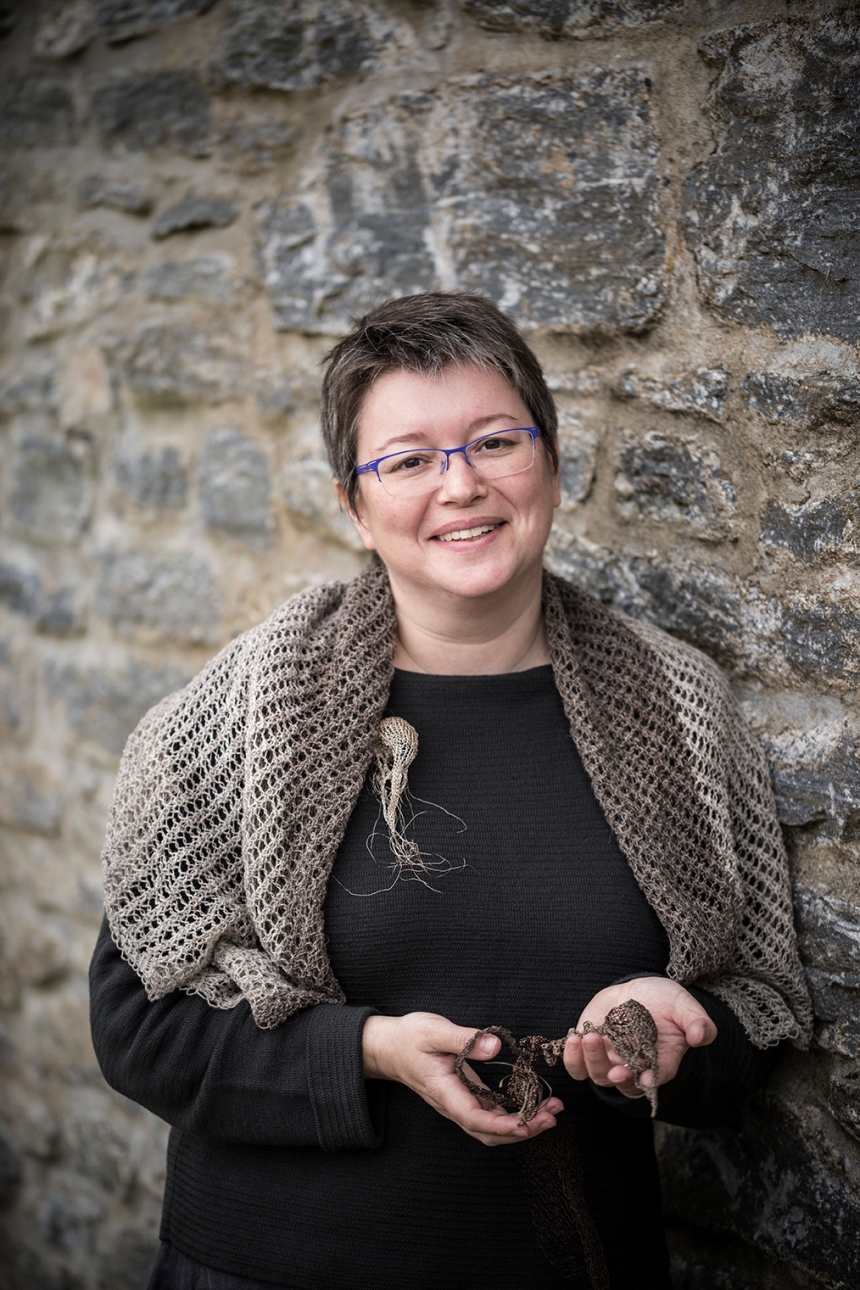
Helen with hand-knitted shawl in natural Shetland colours and Crang (skeleton), a wire-knitted piece inspired by Paula Jenning’s poem Seabird What Has Death Left In Your Belly: “death steals life, but leaves a changeling.”
Thanks so much for this illuminating chat, Helen! You can find out more about Helen’s work through her website and follow her on twitter (@Speedcrafter) or Instagram @helen_robertson_jewellery
Photo credits: Tom Barr (photo of Lerwick, portrait of Helen, photo of Gloup Fishing Disaster piece); Mark Sinclair, Phat Sheep Photography (Crugga window, lace fence); Ella Gordon (Tree of Life earnings), Joy Allan (other photography).


Thank you for sharing this. Helen’s definition of the difference between art and craft will be something I think about for quite some time.
LikeLike
Wonderful art, very inspiring, Great interview, loved it. And I want to reach back through the mists of time and strangle those lairds…grrr. What a terrible, terrible incident for a rather small community. The piece maide in their honour is breathtaking. And another thing – I can see the links between Norway and Shetland in these makes. We don’t have much lace knitting, but the aestethics are closely related. The window with the silver lace reminds me of what I’d see where my grandparents lived on the southern coast of Norway.
LikeLike
Wow, it is the outside work that really caught my attention! The Gloup Fishing Tragedy is just SO sad. That piece is stunning. Thank you.
LikeLike
Met Helen on my last two visits to Shetland. She is a delightful person with a lovely family. Her work is so inspirational both in wool and wire.
I too think her new hairstyle really frames her face well.
Many thanks for this piece Kate and Tom.
LikeLike
This post and the last give pause to think (well, most of your posts do, really, but
I particularly liked these two). Thank you, Kate!
LikeLike
I am going to come back to read this again, and again and again! It is so insightful how such a wonderful artists sees, thinks and translates things into such beauty! Thanks Kate – your writing is always! such an insightful and wonderful read!
LikeLike
Thanks everyone for your lovely comments and thank you Kate. My current website doesn’t really show my work to its best but there is a new one coming very soon! In the meantime please feel free to find me on Facebook (Helen Robertson Jewellery Shetland) or Instagram helen_robertson_jewellery. Thanks, xx
LikeLiked by 1 person
Beautiful lace jewellery/knitting and interesting history
LikeLike
I am blown away by her work! Next stop: her website!
As always, thank you Kate and Tom, for sharing!
LikeLike
That first photo of the lace in the water is breathtaking! What a lovely interview. I feel a real need to own those Tree of Life earrings. :) I also find Crang to be tremendous. What a gorgeous piece.
One of the best interviews I’ve read in ages. Thank you both so much!
LikeLike
Astounding piece in text and art photography. Goodness but the one of the shawl in the water really spoke to me in an intimate way. An Undine… thank you!!
LikeLike
Helen is a very talented lady!
LikeLike
Thank you Kate. I really enjoyed this post on Helen Robertson and find her work and stories riveting.
LikeLike
What an inspirational article. Helen Robertson is a true artist and her pieces are just magnificent. What a harsh life her forebears on Shetland endured. Thank you for this wonderful insight into Helen’s work.
LikeLike
I had the pleasure of meeting Helen at the In the Loop conference is Glasgow last year. Her talk just blew me away. I love her work. This is a lovely post and the photos are, as usual, outstanding. Great one of Helen herself and I really like her new hairstyle!
LikeLike
Thank you so much for this blog. I love Helen’s work and photos are amazing.
LikeLike